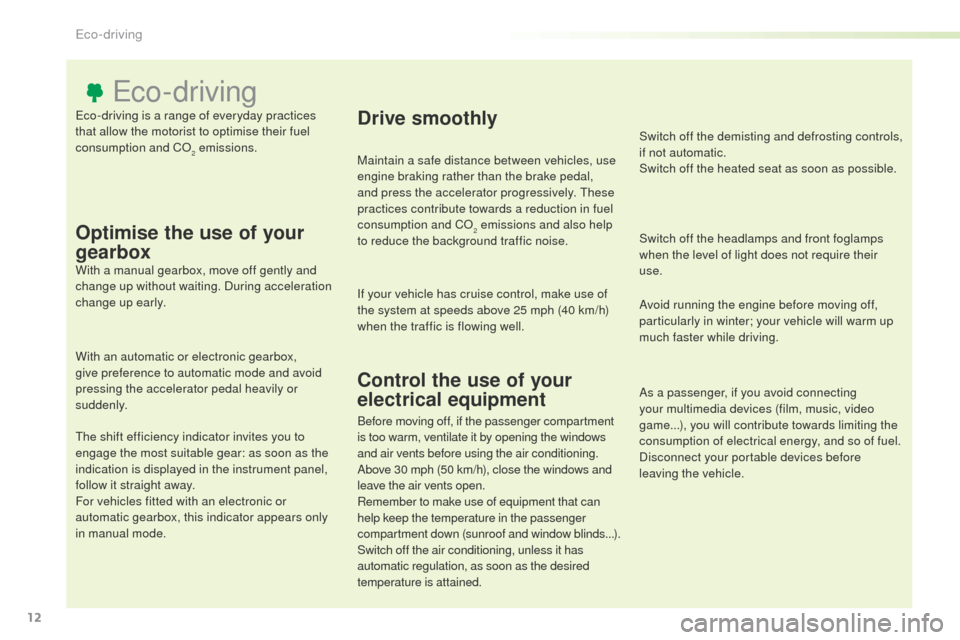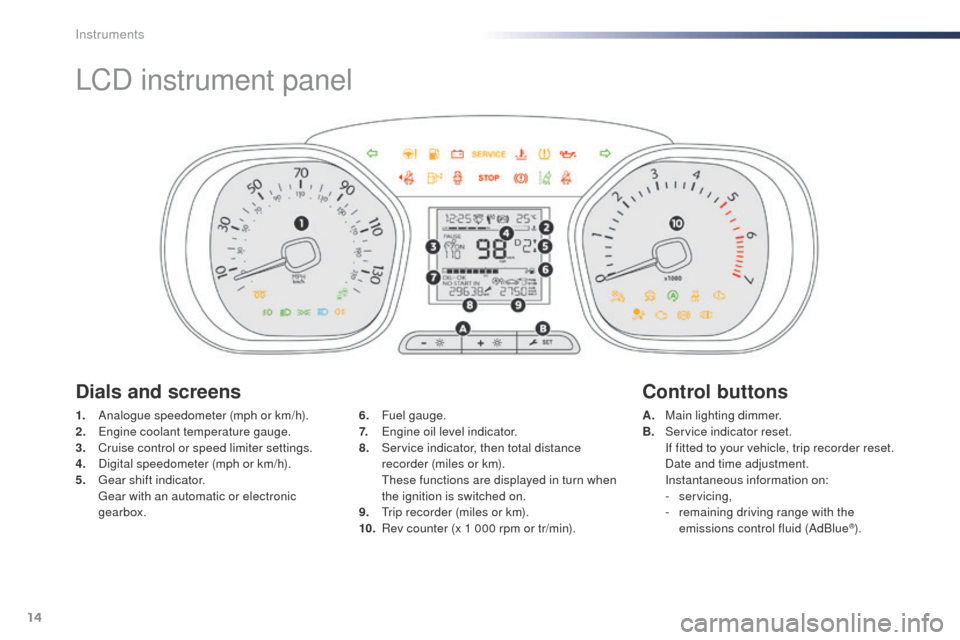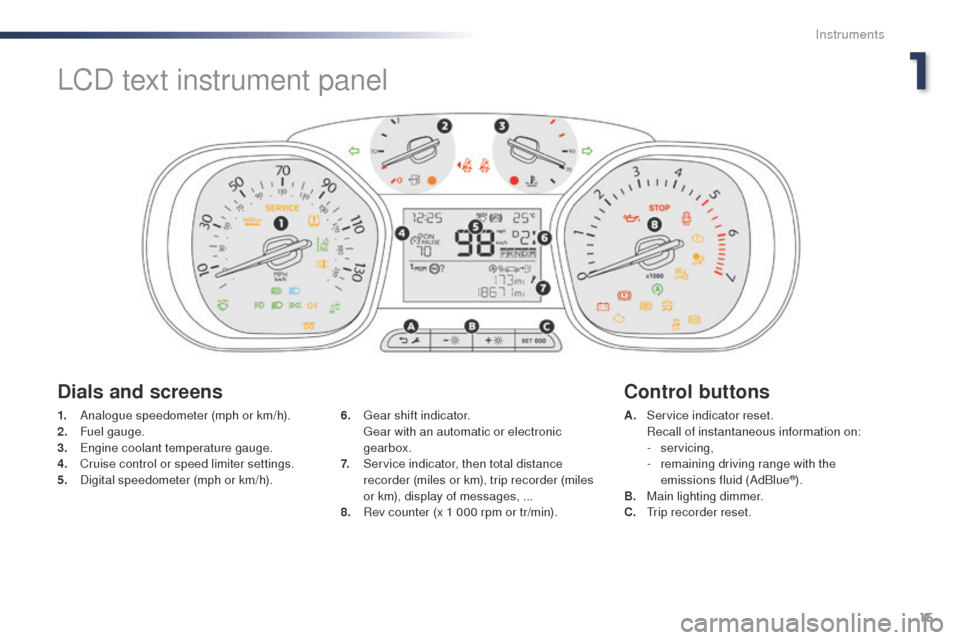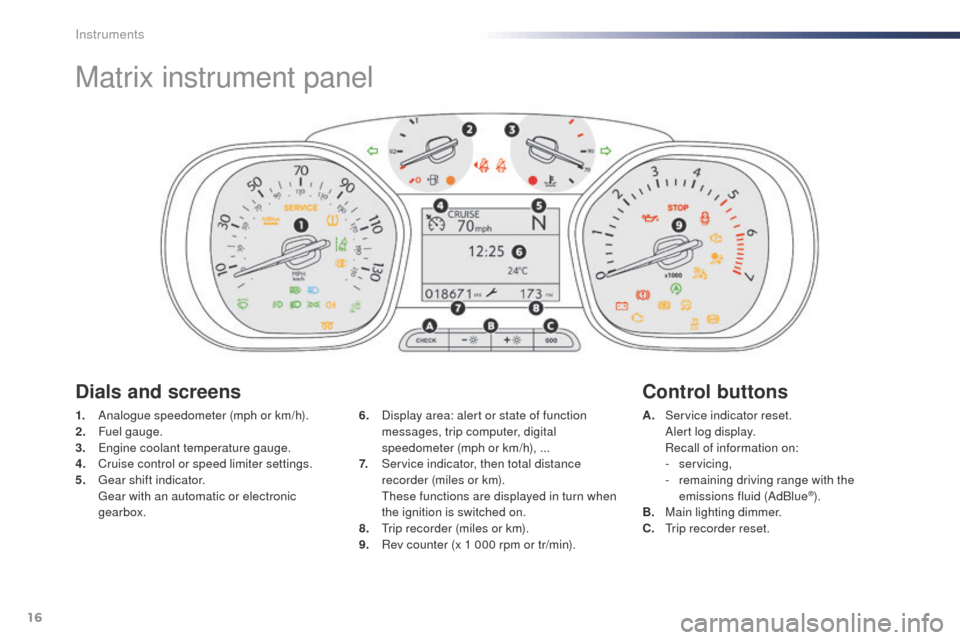2016 Peugeot Expert VU light
[x] Cancel search: lightPage 4 of 520

.
.
over view
Instrument panels 14
Indicator and warning lamps 1 7
en
gine coolant temperature
3
1
Distance recorders
3
8
Lighting dimmer
3
9
tr
ip computer
4
0
to
uch screen
4
3
Setting the date and time
4
6
Key
47
K
ey, remote control
4
7
"Keyless
e
n
try and Starting"
5
5
Locking / unlocking from inside
7
2
Front doors
7
4
Manual sliding side door(s)
7
5
el
ectric sliding side door(s)
7
8
Hands-free sliding side door(s)
87
S
ide-hinged rear doors
9
1
ta
ilgate
94
Alarm
9
5
el
ectric windows
9
8Steering wheel adjustment
9
9
Front seats
9
9
2-seat front bench seat
1
04
Moduwork
106
Fixed one-piece bench seat
1
10
Fixed rear seat and bench seat
1
13
Fixed crew cab 1 17
Interior fittings 1 19
Loading area fittings
1
22
Seating area fittings
1
23
Heating / Ventilation
1
25
Manual air conditioning
1
26
Dual-zone automatic air conditioning
1
28
Front demist - defrost
1
32
Door mirrors demist - defrost
1
33
Rear screen demist - defrost
1
34
Rear Heating - Air Conditioning
1
37
Programmable Heating / Ventilation
1
38
Courtesy lamp(s)
1
41Mir ror s
143
Lighting control stalk
1
46
Daytime running lamps
1
49
Automatic illumination of headlamps
1
49
Automatic headlamp dipping
1
53
Manual headlamp beam height adjustment 1 55
Wiper control stalk 1 56
Automatic rain sensitive wipers
1
57
Hazard warning lamps
1
60
em
ergency or assistance call
1
60
Horn
161
el
ectronic stability control (
e
SC)
1
61
gr
ip control
1
64
Seat belts
1
66
Airbags
1
70
Child seats
1
74
Deactivating the passenger front airbag
1
77
IS
oF
IX mountings
1
86
Manual child lock
1
94
el
ectric child lock
1
94
Child lock on rear windows
1
95
eco-driving
In struments
Access
ea
se of use and comfort
Lighting and visibility
Safety
Labels 11
Contents
Page 6 of 520

4
exterior
Filler cap, fuel tank 265 -266
Misfuel prevention 26 6-267
Running out of Diesel fuel, priming
327
un
der-inflation detection
26
2-264
ty
res, pressures
2
63 -264, 337
e
SC programme
1
61-163
ABS,
e
B
FD
1
62
DSC, ASR
1
63
gr
ip control
16
3, 16 4 -165
Snow chains
2
68
Front doors
7
4-75
AdBlue
® tank 28 3-286to
ol box 2 87-289
Automatic illumination of headlamps
1
49
Automatic headlamp dipping
153 -15 4
Direction indicators 1
48
Manually adjusting the headlamp beam height
1
55
Changing front bulbs
3
03-309
Headlamp wash
1
58
op
ening the bonnet
2
76 Key
47
Key, remote control
4
7-54
Changing the battery, reinitialisation
5
4
Keyless e
n
try
and Starting
5
5-71
Changing the battery, reinitialisation
7
0
Starting - switching off the engine, key, remote control
1
99 -201
Starting - switching off the engine, Keyless e
n
try and starting
2
02-204
Locking / unlocking from inside
7
2-73
Alarm
95-97
Speed limit
recognition
225-228
Collision Risk Alert
2
43 -245
Active Safety Brake
2
43, 246 -248
Fatigue detection
2
50-251
Changing a wiper blade
2
74
Automatic wiping
1
57-158
Front demisting, defrosting
1
32
Front foglamps
1
47, 309
Daytime running lamps
1
49, 305
Cornering lighting
1
52
Parking sensors
2
55-257
to
wing
325-326
over view
Page 9 of 520

7
Locking / unlocking from inside 72-73el
ectric sliding door(s) 7 8 - 86
Cabin / loading area selectivity
4
7-48, 55
el
ectric child lock
1
94
Hazard warning lamps
1
60
Reinitialising the under-inflation detection
26
3-264
Deactivating Stop & Start
2
20
Deactivating the DSC/ASR system
1
63
Adjusting the steering wheel
9
9
Horn
161
Head-up display
2
22-223
Instruments and controls (cont.)
Wiper c ontrol 15
6 -159tr
ip computer 4 0 - 42
Memorising speeds
2
24
Speed limiter
2
29-231
Cruise control
23
2-235
Dynamic cruise control
2
36 -242 Instrument panels
1
4-16
Warning lamps
1
7-30
Coolant temperature
3
1
Service indicator
3
1-33
oi
l level indicator
3
4
AdBlue
® range indicator 3 5 -37
Distance recorder 3 8
ge
ar shift indicator
2
08
Lighting dimmer
3
9
tr
ip computer
4
0 - 42
Setting the time and date
4
6
Fatigue detection
2
50-251
el
ectric windows
9
8
Adjusting the electric mir ror s
143
gr
ip control
16
3, 16 4 -165
Programmable heating / ventilation
1
38-140
Alarm
95-97
Manually adjusting the headlamp beam height
1
55
Lane departure warning system
24
8 -249
Blind spot monitoring system
252-254
Automatic headlamp dipping
153 -15 4
Setting the time and date
4
6
180º Rear vision
2
59 -261
Memorising speeds 2
24
Speed limit recognition 2
25-228, 231, 234, 238
Collision Risk Alert
2
43 -245
Active Safety Brake
2
43, 246 -249
Deactivating Stop & Start
2
20
Lighting control
1
46-151
Direction indicators
1
48
.
over view
Page 14 of 520

12
eco-driving is a range of everyday practices
that allow the motorist to optimise their fuel
consumption and Co
2 emissions.
eco-driving
Optimise the use of your
gearbox
With a manual gearbox, move off gently and
change up without waiting. During acceleration
change up early.
With an automatic or electronic gearbox,
give preference to automatic mode and avoid
pressing the accelerator pedal heavily or
suddenly.
th
e shift efficiency indicator invites you to
engage the most suitable gear: as soon as the
indication is displayed in the instrument panel,
follow it straight away.
For vehicles fitted with an electronic or
automatic gearbox, this indicator appears only
in manual mode.
Drive smoothly
Maintain a safe distance between vehicles, use
engine braking rather than the brake pedal,
and press the accelerator progressively.
t
h
ese
practices contribute towards a reduction in fuel
consumption and C
o
2 emissions and also help
to reduce the background traffic noise.
If your vehicle has cruise control, make use of
the system at speeds above 25 mph (40 km/h)
when the traffic is flowing well.
Control the use of your
electrical equipment
Switch off the demisting and defrosting controls,
if not automatic.
Switch off the heated seat as soon as possible.
Switch off the headlamps and front foglamps
when the level of light does not require their
use.
Avoid running the engine before moving off,
particularly in winter; your vehicle will warm up
much faster while driving.
As a passenger, if you avoid connecting
your multimedia devices (film, music, video
game...), you will contribute towards limiting the
consumption of electrical energy, and so of fuel.
Disconnect your portable devices before
leaving the vehicle.
Before moving off, if the passenger compartment
is too warm, ventilate it by opening the windows
and air vents before using the air conditioning.
Above 30 mph (50 km/h), close the windows and
leave the air vents open.
Remember to make use of equipment that can
help keep the temperature in the passenger
compartment down (sunroof and window blinds...).
Switch off the air conditioning, unless it has
automatic regulation, as soon as the desired
temperature is attained.
eco-driving
Page 16 of 520

14
LCD instrument panel
1. Analogue speedometer (mph or km/h).
2. eng ine coolant temperature gauge.
3.
C
ruise control or speed limiter settings.
4.
D
igital speedometer (mph or km/h).
5.
g
e
ar shift indicator.
g
e
ar with an automatic or electronic
gearbox. A. M
ain lighting dimmer.
B. S ervice indicator reset.
I
f fitted to your vehicle, trip recorder reset.
D
ate and time adjustment.
I
nstantaneous information on:
-
servicing,
-
r
emaining driving range with the
emissions control fluid (AdBlue
®).
6.
F
uel gauge.
7.
e
n
gine oil level indicator.
8.
S
ervice indicator, then total distance
recorder (miles or km).
t
h
ese functions are displayed in turn when
the ignition is switched on.
9.
t
r
ip recorder (miles or km).
10. R
ev counter (x 1 000 rpm or tr/min).
Dials and screens
Control buttons
Instruments
Page 17 of 520

15
1. Analogue speedometer (mph or km/h).
2. Fuel gauge.
3.
e
ng
ine coolant temperature gauge.
4.
C
ruise control or speed limiter settings.
5.
D
igital speedometer (mph or km/h). A. S
ervice indicator reset. R
ecall of instantaneous information on:
-
servicing,
-
r
emaining driving range with the
emissions fluid (AdBlue
®).
B. M
ain lighting dimmer.
C.
t
r
ip recorder reset.
6.
g
e
ar shift indicator.
g
e
ar with an automatic or electronic
gearbox.
7.
S
ervice indicator, then total distance
recorder (miles or km), trip recorder (miles
or km), display of messages, ...
8.
R
ev counter (x 1 000 rpm or tr/min).
Dials and screens Control buttons
LCD text instrument panel
1
Instruments
Page 18 of 520

16
Matrix instrument panel
1. Analogue speedometer (mph or km/h).
2. Fuel gauge.
3.
e
ng
ine coolant temperature gauge.
4.
C
ruise control or speed limiter settings.
5.
g
e
ar shift indicator.
g
e
ar with an automatic or electronic
gearbox. A. S
ervice indicator reset. A
lert log display.
R
ecall of information on:
-
servicing,
-
r
emaining driving range with the
emissions fluid (AdBlue
®).
B. M
ain lighting dimmer.
C.
t
r
ip recorder reset.
6.
D
isplay area: alert or state of function
messages, trip computer, digital
speedometer (mph or km/h), ...
7.
S
ervice indicator, then total distance
recorder (miles or km).
th
ese functions are displayed in turn when
the ignition is switched on.
8.
t
r
ip recorder (miles or km).
9.
R
ev counter (x 1 000 rpm or tr/min).
Dials and screens Control buttons
Instruments
Page 31 of 520

29
Warning / indicator lampStateCause Action / Observations
Automatic
wiping fixed.
th
e wiper control has been pushed
down. Automatic front wiping is activated.
to d
eactivate automatic wiping, operate the control
stalk downwards or put the stalk into another position.
Automatic
headlamp
dipping fixed.
th
e lighting control stalk is in
the
"AUTO " position, and the function
has been activated.
th
e main beam headlamps come
on if the exterior lighting and driving
conditions permit.
th
e camera, located at the top of the windscreen,
manages the operation of main beam, depending on
the ambient lighting and driving conditions.
For more information on Automatic headlamp
dipping , refer to the corresponding section.
Stop & Star t fixed. When the vehicle stops (red lights,
traffic jams,
...) the Stop & Start
system has put the engine into S
t
o
P
m
ode.
th
e warning lamp goes off and the engine restarts
automatically in S
tA
R
t
mode, as soon as you want to
move off.
flashes for a few
seconds, then goes
of f. S
t
o
P m
ode is temporarily
unavailable,
or
S
tA
R
t
mode is invoked
automatically. For more information on Stop & Star t
, refer to the
corresponding section.
Blind spot
monitoring
system fixed.
th
e blind spot monitoring system has
been activated. For more information on the Blind spot monitoring
system, refer to the corresponding section.
Lane departure
warning system
fixed.
th
e lane departure warning system
has been activated.
th
e lane departure warning system is on.
For more information on the Lane departure warning
system, refer to the corresponding section.
1
Instruments